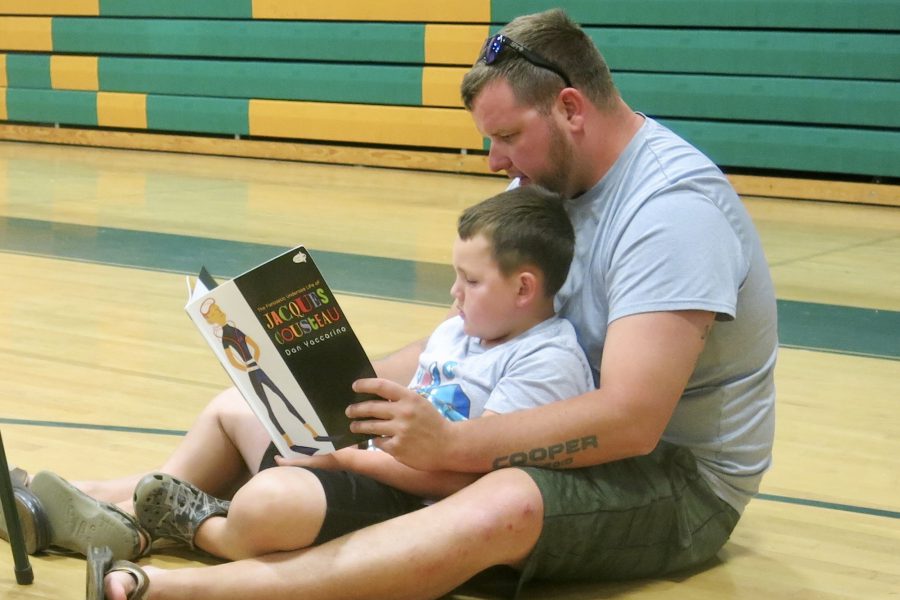
While schools do a lot to promote and improve literacy skills in young readers, there is still a lot you can do at home to help your child succeed. Just because a child has learned to read doesn’t mean that he or she no longer appreciates, or wouldn’t benefit from, reading aloud with an adult. Listening to books read out loud, or reading them alongside an adult (i.e. engaging the child through questions and fill-in-the-blanks), in addition to reading independently, helps young readers maintain their literacy skills. Continue with read-alouds for as long as possible. Older kids and strong readers might be ready for chapter book read-alouds. Choose chapter books that are one or two years above your child’s reading level. This will expose your child to new vocabulary and higher-level concepts. This vocabulary and these concepts will be included in the books your child will grow into and will start to read next. Consider reading a chapter or two each night. You can both look forward to reading the next installment together, and can discuss the book during the day (for instance, ask what he or she thinks will happen next, or what his or her favorite part so far is). Don’t be afraid to make silly faces and use silly voices. Let your child see you enjoying yourself. Not only will it encourage your child to enjoy reading, too, but reading aloud together is a special time when they have your full attention.
Reading practice is essential to becoming a successful reader and to maintaining literacy skills. Even strong readers need to practice. Research shows that children with the highest achievement percentiles are also the children with the highest reading volume. Help your child follow through with regular practice. A decent goal is 25 or more “on-level” books outside of school per year.
How do you encourage regular reading at home? By making reading part of the home routine. This includes making time for reading (alone and together) and keeping books within arm’s reach. If books are placed where your child can see them and reach for them, your child will more likely pick them up and read them. Place books around the house where your child will see them and pick them up. Give your child a bookshelf in his bedroom and help him keep those shelves filled with his favorites. Remember to keep a few books in the car, too, and anywhere you go where you have some downtime.
It’s also important for you to read on your own regularly. If your kids see you reading for fun, they’ll be more likely to pick it up. If reading is a consistent part of your life, it will become a part of your child’s life as well. Remember to talk about what you are reading too. Ask questions about the books they read, and talk about books you’ve read and enjoyed. It’s not only a good conversation starter, but also helps them process what they read and engage with it on a deeper level.
As young readers become more confident, introduce new and more challenging vocabulary words. Most vocabulary is learned indirectly through everyday experiences through both spoken and written language. Point out new words on signs, magazines or other print materials, cereal boxes or packaging, and everywhere you find them. This indirect learning occurs most often in the following three ways: 1. engaging daily in oral language, 2. listening to adults read out loud, and 3. reading extensively and independently. Talk with your child, read to your child, and encourage your child to read every day. Some vocabulary must be taught, so for teaching, be selective. Choose useful words, popular words, and as they learn more, perhaps difficult words. There is no need to teach every word in the English language. Because readers learn new words by hearing them, reading them, and mostly by using them, exposure and practice is necessary. Pick a word of the day to post on the refrigerator, make a long list of the words, and continue to use them all.
When your child comes across an unknown word, ask him or her to break the word into parts. First, look for words within the unknown word. Some of the smaller words might give clues about pronunciation or meaning. Second, look for word beginnings and endings. Some of these might give clues, too. For example, un– means not, re- means again, and –er often means someone who. Third, help with context clues. Encourage your child to read to the end of the sentence. Other words in the sentence might give a meaning clue. Finally, there are always other sources, and you may need to teach your child to go to another source. This includes the dictionary, the computer, or asking someone.
Here are some techniques to help your child become a more active reader and improve his comprehension. Before starting a read-aloud or silent reading session, encourage your child to think about what the reading is going to be about. What is the title of the book or chapter? Does this give any clues as to the main ideas and details to follow? Now look for other clues. Look at any pictures to see if these give additional clues. Make connections to current knowledge. How is this similar to something seen before? This helps to give your child some ideas and foundations for the reading.
Ask open-ended questions about what your child is reading, such as “Why do you think that character made this choice? How do you think that’s going to work out?” These kinds of questions elicit responses that build background information and improve reading for meaning. Some open-ended questions needn’t be answered. It’s just important to ask the question and set a purpose for the reading. Making inferences is tricky, so recognize that this process may need to be taught first. Real-life examples work well. For instance, when a child walks into the house from the outside and puts a dripping wet raincoat away, then the inference can be that it is raining outside. Then relate inference skills to the reading. When the main character gets something he or she has wanted for a long time, the inference could be made that he or she is happy. Prompt your child to predict what will happen in the story based on what they already know. Some inferences will be correct, and others will not. Be lenient here about accepting non-exact answers in order to keep your child reading. Refine the expectations and answers as your child grows. What’s most important is considering all the possibilities and reflecting upon the reading.
Sometimes readers get bogged down in a lot of information and a lot of details. Some readers just need to focus on the main idea and a few details. Choose what’s most important, pull together some of the pieces in a reading passage, and help your child to summarize that information in a sentence or two. Sometimes reviewing the main idea is all a reader needs to be sure he or she s reading for meaning and getting something out of the reading. Help your child make some connections. These connections could be text-to-self, text-to-world, and/or text-to-text connections (that is, connecting to the child’s life, related to their world at large, or related to something else they’ve read).
While it’s extremely important to talk about the reading, this talking doesn’t have to be long or too in-depth. Read a selection and think aloud about what’s happening in the reading. It may be beneficial to explain something that your child doesn’t know. If you or your child knows something more about a topic, then talk about it (Is your son or daughter obsessed with dinosaurs? All what kind of dinosaur is that? What do they eat again? etc.). This will help build the background knowledge necessary for further reading and understanding. It is also beneficial to create questions, not answers, just questions. This will give your child a purpose for reading, something to think about when reading, and will improve overall comprehension.
You are a positive role model, and modeling is necessary. Read with expression and read fluently to your child. There are several ways to model fluent reading at home. In paired reading, you and your child read together at the same time. With echo reading, you read a sentence and your child rereads the same sentence like an echo. In addition, there is shared reading. You read some, and your child reads some.
Remember that even successful readers still appreciate being read to. This is helpful for continued comprehension improvement, because listening vocabulary is often more advanced than reading vocabulary. Your child can concentrate on meaning alone, and then take over the reading at some point. You can also read the first half of a page to your child, then pose a question, and ask your child to read the rest of the page, looking for the answer to that question. Chapter books offer the chance to alternate chapters between parent and child. Remember to talk about the reading, laugh at the funny parts, and make the experience as fun and positive as possible. The more fun reading becomes, the more your kids will want to read!
10 Ways to Help Maintain Reading Skills
- Remember that practice is the key to maintaining skills.
2. Make sure your child reads 25 or more on-level books per year, outside of school, to maintain skills.
3. Stop at the bookstore or library often. Try to stop whenever asked. Answering those requests will be vital to maintaining skills.
4. Let your children see you reading too. You are a valuable role model.
5. Work on vocabulary by talking with your child often.
6. Make some flash cards with words on one set of cards and matching definitions on another set of cards. Create some word games like Memory, Old Maid, or Go Fish. Play Make a Face with special words. Play Tic-Tac-Toe using words.
7. All family members search for new vocabulary words and definitions to share at the dinner table. Expand with additional discussions and conversation.
8. Discuss what you’re reading before and during as well as after the reading.
9. Make connections to the reading. Text-to-self, Text-to-world, and Text-to-text.
10. Model fluent reading. Read aloud to your child to show what expressive and smooth reading sounds like.
Bruce Johnson is an educator, reading specialist at the Merrimack Valley School District in New Hampshire, member of CLiF’s Advisory Board, and author of Helping Your Child Become a Successful Reader: A Guide for Parents. Learn more at www.guidesforparents.wordpress.com.



